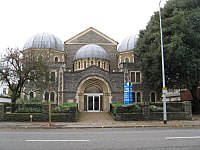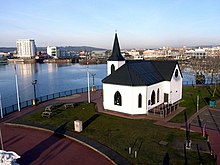Religion in Wales
Some modern surveys have suggested that most Welsh people do not identify with any religion and record significantly less religious feeling in Wales than in other parts of the UK.
The writer Gildas drew sharp contrasts between the Christian Welsh at this time and the pagan Anglo-Saxon invaders.
However, a combination of Celtic Christianity's reconciliation with Rome and the English conquest of Wales meant that from the Middle Ages, the Welsh dioceses became part of the Province of Canterbury.
They were all Catholic until the Reformation broke with Rome and created the Church of England under the control of King Henry VIII.
[citation needed] Bishop Richard Davies and dissident Protestant cleric John Penry introduced Calvinist theology to Wales.
Calvinism developed through the Puritan period, following the restoration of the monarchy under Charles II, and within Wales' Methodist movement.
[7] Some books of the Bible and the Apocrypha had been translated in the Middle Ages, but the Acts of Union (1536–43) passed under King Henry VIII effectively banned the Welsh language from official use.
However, under Queen Elizabeth I, the English Parliament passed the An Act for the Translating of the Bible and the Divine Service into the Welsh Tongue 1563.
This had a significant role in its continued use as a means of everyday communication and as a literary language down to the present day despite the pressure of English.
[citation needed] Abuses did occur, and in the 18th century some bishops granted benefices in Welsh-speaking areas to English clergy who did not speak Welsh.
[9] In 1766 the churchwardens of the parish of St Beuno, Trefdraeth on Anglesey, supported by the Cymmrodorion, began a test case against an English clergyman, Dr Thomas Bowles, who could not conduct services in Welsh and whose attempt to do so had ended in ridicule.
[8] In its verdict in 1773 the Court of Arches refused to deprive Dr Bowles of his living, but did lay down the principle that clergy should be examined and found proficient in Welsh in order to be considered for Welsh-speaking parishes.
The established Church of England recovered slowly from the widespread damage brought about by the English Civil War, and the Puritan Commonwealth of Cromwell, in the mid-17th century.
[citation needed] The Welsh Methodist revival also had an influence on the older nonconformist churches, or dissenters – the Baptists and the Congregationalists – who in turn also experienced growth and renewal.
Roman Catholicism kept pace with demographic growth, but, even reinforced by Irish immigration, remained a limited force in 1840.
Nonconformists, led by Liberal David Lloyd George, increasingly controlled the politics of Wales, although the elite sectors were still dominated by the Anglicans.
[14] Despite this, by 2011 South Wales (and especially settlements in the former coalfield area) showed the highest proportions of no religion anywhere in the country, rising in places to over 50%.
In August 1911, in a period of public disorder and industrial disputes, Jewish shops across the South Wales coalfield were damaged by mobs.
[29] Commenting on the figures, Humanists UK said: "[T]he results show that Wales faces a non-religious future, and that public bodies need to keep up with today’s demographics.



